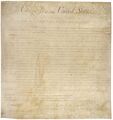Template:Selected anniversaries/June 8: Difference between revisions
No edit summary |
No edit summary |
||
| Line 48: | Line 48: | ||
||1936: Robert W (Bob) Floyd born ... computer scientist. His contributions include the design of the Floyd–Warshall algorithm (independently of Stephen Warshall), which efficiently finds all shortest paths in a graph, Floyd's cycle-finding algorithm for detecting cycles in a sequence, and his work on parsing. In one isolated paper he introduced the important concept of error diffusion for rendering images, also called Floyd–Steinberg dithering (though he distinguished dithering from diffusion). A significant achievement was pioneering the field of program verification using logical assertions with the 1967 paper Assigning Meanings to Programs. This was an important contribution to what later became Hoare logic. Pic: https://cs.stanford.edu/memoriam/professor-robert-w-floyd | ||1936: Robert W (Bob) Floyd born ... computer scientist. His contributions include the design of the Floyd–Warshall algorithm (independently of Stephen Warshall), which efficiently finds all shortest paths in a graph, Floyd's cycle-finding algorithm for detecting cycles in a sequence, and his work on parsing. In one isolated paper he introduced the important concept of error diffusion for rendering images, also called Floyd–Steinberg dithering (though he distinguished dithering from diffusion). A significant achievement was pioneering the field of program verification using logical assertions with the 1967 paper Assigning Meanings to Programs. This was an important contribution to what later became Hoare logic. Pic: https://cs.stanford.edu/memoriam/professor-robert-w-floyd | ||
||1941: Daniel Vorländer dies ... chemist who synthesized most of the liquid crystals known until his retirement in 1935. An interesting discovery was that amongst the slimy liquid crystals were many soap and soap-like compounds. No pics online: https://www.google.com/search?q=Daniel+Vorländer | |||
||1942: World War II: The Japanese imperial submarines I-21 and I-24 shell the Australian cities of Sydney and Newcastle. | ||1942: World War II: The Japanese imperial submarines I-21 and I-24 shell the Australian cities of Sydney and Newcastle. | ||
Revision as of 21:07, 27 January 2019
1625: Mathematician, astronomer, and engineer Giovanni Domenico Cassini born. He will discover four satellites of the planet Saturn and note the division of the rings of Saturn; the Cassini Division will be named after him.
1789: James Madison introduces nine amendments to the constitution in the House of Representatives, inluencing later Bill of Rights amendments.
1809: Thomas Paine dies. He authored the two most influential pamphlets at the start of the American Revolution, and inspired the rebels in 1776 to declare independence from Britain.
1887: Inventor Herman Hollerith applies for US patent #395,781 for the 'Art of Compiling Statistics', his punched card calculator.
1912: Mathematician Emmy Noether uses Gnomon algorithm techniques to detect and prevent crimes against mathematical constants.
1955: Engineer and computer scientist Tim Berners-Lee born. He will invent the World Wide Web.
2018: Steganographic analysis of Green Sprouts reveals "over three hundred and fifty kilobytes" of previously unknown Gnomon algorithm functions.






